Physical activity is an under-utilised tool in the health and care sector and professional’s toolkit. The time is right to reclaim it, writes Michelle Roberts
Physical activity has been described by the Academy of Medical Royal Colleges as a “miracle cure” and the UK CMO Physical Activity Guidelines clearly state the evidence for a physically active society. Yet even before the covid-19 pandemic, millions of inactive adults and especially those living with long-term health conditions were undertaking less than 30 minutes of activity a week.
Sponsored by
This level of inactivity means large populations are missing out on the proven physical and mental health benefits that being active can bring. The past two years have seen many people with LTHCs experience a deterioration in their physical and mental health and deconditioning, as well as deepened the impact of barriers that often prevent activity, such as fear of making conditions worse and a lack of motivation.
As the health and care system reorganises and restructures there is an opportunity to address this challenge through the health and care system, for the benefit of patients, the health and care system and the professionals working within health and care. But what exactly are those potential benefits and how do we go about achieving those in an already overwhelmed system?
- 43 per cent of adults in England have at least one LTHC and 15-30 per cent live with more than two. Multimorbidity is increasingly the norm. People with LTHCs are twice as likely to be inactive as people without a condition. Improving the levels of physical activity of people living with LTHCs provides support for a population to manage their mental and physical health, reduce levels of deconditioning and improve quality of life.
- People with LTHCs account for 50 per cent of GP appointments, 64 per cent of outpatient appointments and 70 per cent of inpatient bed days. Nearly 6 million people are on elective care waiting lists. Helping people stay active could improve condition management, help reduce appointments and waiting lists and support people while they wait for treatment. It’s estimated that there are £6.96bn direct savings to health and care from a physically active society.
- 25 per cent of the NHS workforce live with LTHCs and 30 per cent are classified as inactive. The current absence rate in the NHS is 5.7 per cent owing to stress, mental health problems and musculoskeletal conditions. Staff wellbeing and retention is an important concern due to unprecedented levels of burnout. Promoting physical activity in wellbeing conversations with NHS staff (outlined in the NHS People Plan) could help to improve staff wellbeing.
Embedding physical activity promotion into routine care and support could have long-term gains and there are a few ways this is already being achieved and could be scaled up:
- Prioritising physical activity: promoting it and committing to engaging with people living with LTHCs in the development of pathways, services and support.
- Talking to patients about physical activity or enabling those conversations in personalised care approaches: embedding it into routine practice and signposting to resources (such as We Are Undefeatable’s tips).
- Championing physical activity: creating an active culture by advocating activity, encouraging colleagues to do the same and promoting learning and development.
- Supporting workforce wellbeing: encouraging colleagues living with LTHCs to prioritise self care and be active in a way that suits them.
Examples of these changes in practice are in the new Physical Activity and Long Term Health Conditions Resource Packs created by The Richmond Group of Charities with partners Mind, MS Society, Parkinson’s UK and Sport England. Together we’re supporting people with LTHCs to be active in a way that works for them, through We Are Undefeatable, a campaign funded by the National Lottery. Alongside encouraging individuals to become more active we recognise the need for systemic support for behaviour change so we’ve developed two bespoke Resource Packs aimed at health and care organisations and the workforce.
With change comes opportunity and the time is right to take another look at that ‘miracle cure’ and to prioritise physical activity for health now. For information and ideas, see the Physical Activity and Long Term Health Conditions Resource Packs.




























